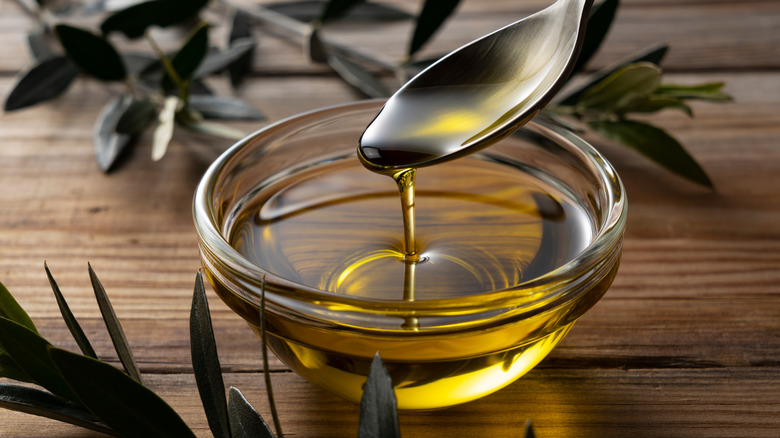'Light' Olive Oil Probably Doesn't Mean What You Think It Means
Many cultural relics of the '90s have gracefully aged into 2023. The funky music, the baggy jeans, and the cartoon TV shows all continue to hold a special place in our collective hearts. Other aspects of the decade, though, are more than welcome to stay in the past. And the low-fat food craze certainly fits the second category.
This diet fad sold a narrative about the elimination of fat being the key to weight loss (a claim that has been debunked), fearmongered to the public about a vital, basic nutrient, and led to a plethora of food products that were stripped of fat and subsequently pumped with sugar to ensure the products still had some semblance of flavor.
Throughout the decade, buzzwords such as "low-fat," "fat-free," and "light" adorned packaged foods on every grocery store shelf. Although the fat-conscious phase has more or less fizzled out, with the definition of "light" that we've become conditioned to understand, it's no wonder many people think "light olive oil" falls into the reduced-fat food category. The truth about this olive oil variety, therefore, may come as a surprise.
The real differences
When scanning the oil section of the grocery store, you may find it to be stocked with more varieties of olive oil than you had thought existed. Extra-virgin, virgin, cold-pressed, light, extra-light — the options are endless.
And even though a calorie-conscious shopper may instinctually reach for the "light" olive oil they spot on the shelf, flipping to the nutrition label on the back of the bottle reveals an unexpected truth. Light olive oil is identical to its shelf neighbors, at least from a nutritional standpoint. Just like with extra virgin olive oil, one tablespoon of light olive oil contains 120 calories and 14 grams of fat.
Instead of referring to the calorie and fat content, the light descriptor refers to the mild color and taste of the oil, as compared to its darker and more flavorful counterparts. Light olive oil would more accurately be referred to as light-tasting. (That's why, with olive oil brands such as Bertolli or Pompeian, you'll notice the bottles boast "light taste," specifically.)
When is it best to go light?
So, why go for light-tasting olive oil, if not to hop on an unfounded diet bandwagon? Light-tasting olive oil is more refined than the darker oils. This means that the oil has been processed to the point of neutralizing the taste and aroma of its olive origins. With its fainter flavor profile (thanks to the refinement process), light olive oil makes a more subtle addition to recipes than a more flavor-pronounced virgin olive oil.
Additionally, the refinement of light-tasting olive oil leads to a higher smoke point than a virgin oil, which makes it more ideal for frying, sautéing, and other heat-heavy cooking methods.
The bottom line is, light-tasting olive oil isn't a "better" or "worse" choice than any other olive oil variety. When choosing from that overwhelming selection of olive oils, the choice should ultimately come down to how you intend to use your oil in meal preparation, and how much you prefer the olive essence to come through. '90s diet culture, dismissed.


